Aurora, CO Pollen and Allergy Report for Summer 2023
Pollen Allergy Trends in Aurora, CO
When is pollen lowest in Aurora, CO?

February
Lowest month total PPM
Avg. PPM
When is pollen highest in Aurora, CO?

March
Highest month total PPM
Avg. PPM
How does pollen in Aurora, CO compare to Colorado?
Aurora has a lower average PPM than the state of Colorado.
Aurora yearly avg PPM:
Colorado yearly avg PPM:
How does pollen in Aurora, CO compare to the USA?
Aurora has a lower average PPM than the USA.
Aurora yearly avg PPM:
USA yearly avg PPM:
Is pollen worse this year in Aurora, CO?
Spring 2023 was worse than spring 2022.
Spring 2023 PPM:
Spring 2022 PPM:
Average PPM in Aurora, CO


Aurora, CO Pollen and Allergy Breakdown by Month
Grass
When is grass pollen highest in Aurora, CO?
May has the highest grass pollen in Aurora, CO with an average PPM of
When is grass pollen lowest in Aurora, CO?
April has the lowest grass pollen in Aurora, CO with an average PPM of
Tree
When is tree pollen highest in Aurora, CO?
March has the highest tree pollen in Aurora, CO with an average PPM of
When is tree pollen lowest in Aurora, CO?
May has the lowest tree pollen in Aurora, CO with an average PPM of
Weed
When is weed pollen highest in Aurora, CO?
November has the highest weed pollen in Aurora, CO with an average PPM of
When is weed pollen lowest in Aurora, CO?
February has the lowest weed pollen in Aurora, CO with an average PPM of
Aurora, CO Pollen Monthly Breakdown by Pollen Type


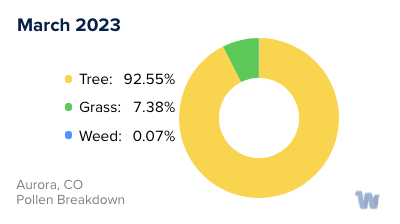


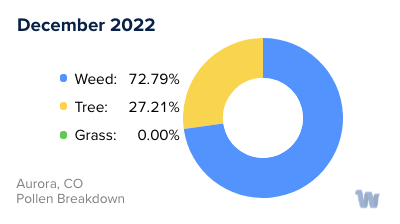
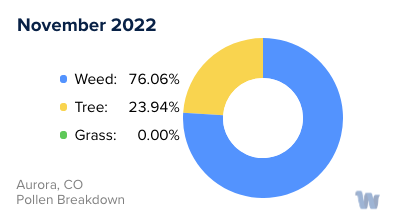
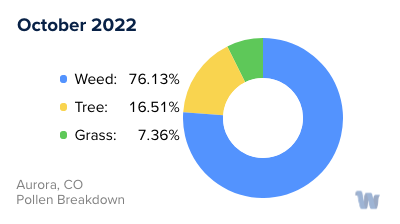

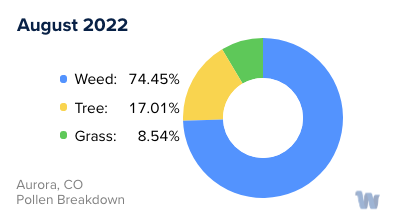

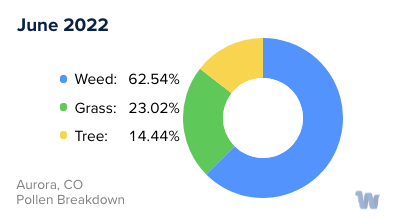

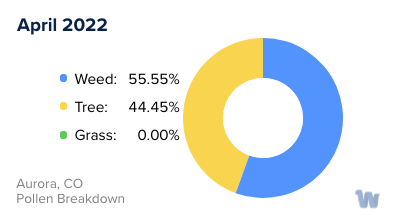
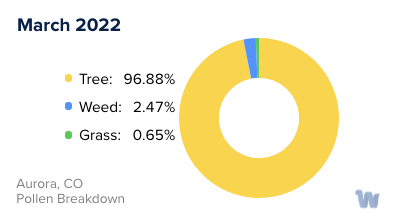
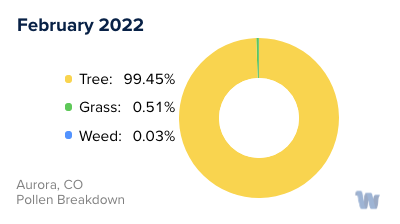
Pollen and Hay Fever in Aurora, CO
In Aurora, Colorado, the beautiful seasons come with a less welcome visitor: pollen. An understanding of pollen types and their peak seasons can help you better navigate pollen allergies, also known as hay fever, in the area.
Pollen allergies in Aurora, Colorado, are primarily instigated by pollen from grasses, trees, and weeds. Each type of plant releases its pollen at specific times of the year, causing seasonal allergies.
In the spring, the majority of allergies are due to tree pollen. The trees that commonly contribute to seasonal allergies include the Elm tree, Cottonwood tree, Aspen tree, Juniper tree, Cedar tree, Oaktree, and Maple tree. As the season progresses towards summer, grass pollen takes center stage, triggering allergic responses in many individuals.
If you experience seasonal allergies in the fall, the culprit is likely pollen from weeds, including Tumbleweed, Sagebrush, and Ragweed. These types of weeds are prevalent in the Aurora region and release their pollen in the cooler months.
The allergy season in Colorado usually commences in the spring, often at the end of February, making it somewhat shorter than in other states. Thanks to Colorado's cold winters, residents typically get a break from their seasonal allergies at the first winter freeze. This respite, however, does not mean an absence of allergens. Indoor allergens can still pose issues for many allergy sufferers during the colder months.
As a resident or visitor to Aurora, you'll want to be particularly mindful of pollen counts in April, May, and June. These months typically see seasonal allergies at their peak. During these periods, pollen counts tend to be lower in the evenings, so it might be beneficial to schedule outdoor activities during those times.
By familiarizing yourself with these pollen types and their peak seasons, you can better anticipate and navigate the challenges of pollen allergies in Aurora, Colorado.


